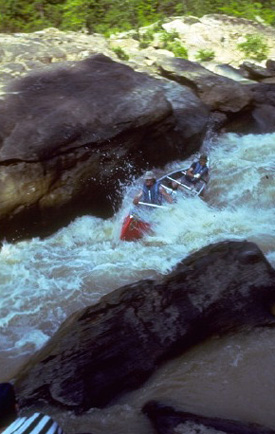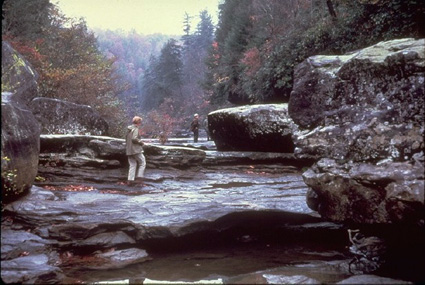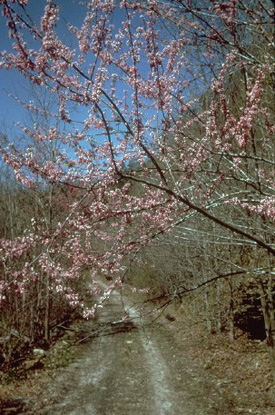
Feeding wild animals can be dangerous
As today’s culture becomes more urban, campers and visitors think of wild animals at Big South Fork National River and Recreation Area in Oneida, Tenn., as well as in state and national parks across the country as a recreational petting zoo, an added feature and activity to their overall camping experience.
“We have a saying here at Big South Fork that tourists leave their common sense at home. They walk around barefoot but here we have the threat of bats and copperhead snakes,” said Tom Blount, chief of Resource Management at Big South Fork National River and Recreational Area, located in north central Tennessee and southeastern Kentucky.
 |
A man canoes on the Big South Fork River that flows through the Cumberland Plateau (Photo courtesy of the National Park Service). |
Campers in Big South Fork and elsewhere across the nation are less concerned with wild animals such as bats, bears, raccoons, bison and alligators posing a legitimate threat to their safety.
Visitors welcome these animals as an added attraction but unknowingly, humans are posing detriment harm to these critters as well as putting their own lives in danger.
“Our responsibility is to protect the public from the wildlife and the animals from the public. There is a balance to maintain. We are very careful and take lots of efforts of making trash receptacles available. We take extra precautions on high-traffic holidays like July 4 and the park maintains its food storage requirements such as hanging trash,” said Blount about the precautions taken within Big South Fork.
In Big South Fork, the staff and visitors maintain coexistence between the wildlife and the 700,000 visitors that trek thru each year and the 35,712 campers that stay in the developed campgrounds. This is executed by educating the public about the affects of feeding the animals which is no easy feat, but this problem is something that is never solved, rather an ongoing challenge.
“We take a strong, active role by handing out citations to campers who do not comply with our rules,” said Blount.
“When raccoons and possums get into campgrounds, they get use to people being around, and the fear of humans is lost,” said Blount about wildlife being attracted away from the fringe of the forest.
“Humans do not think of animals as wild anymore. A raccoon looks docile and tame but it can take your fingers off,” adds Howard Duncan, an interpretive ranger at Big South Fork National Park.
“The threat to the animals eating human food is easy, they die,” said Blount about the harm to wildlife.
“A reason why we do not have as many habitual problems with animals on campgrounds is because in addition to citations we also, allow hunting. Outside of the safety zones, animals know they will be shot,” said Blount.
“Hunters can hunt a variety of game here like game birds, wild turkey, deer and boar. When campers draw animals from their natural habitat, the animals know they’ll get food for no effort. There not being ‘wild’ and aren’t as healthy,” said Duncan about the major kinds of animals hunted at Big South Fork.
As opposed to larger national parks out west like Yellowstone, and Big South Fork’s neighboring national park, the Great Smoky Mountain National Park, animals are used to tourists because humans are a constant.
At Yellowstone, bear cubs learn from observation through their parents on how to break into cars and coolers.
Tourists increasingly come from metropolitan areas and often forget how rural Big South Fork truly is.
“Tourists forget their wild animals, but rather a zoo. They don’t mind getting in close to them. When a camper gets bit from a copperhead, the camper has forgotten this is a natural area that is isolated. These animals are not accustomed to humans,” said Blount about visitors’ lack of common sense.
“We recently had an incident with a rabid bat biting a visitor on a campground. We treated the camper and closed the shelter and rid the bats from the area,” said Blount.
 |
Two hikers explore the Cumberland Plateau (Photo courtesy of the National Park Service). |
Humans forget that these animals that populate the park such as white tail deer protect their young. Humans want to make campgrounds a petting zoo, but bucks have antlers. Through education, animal proof trashcans, and citations, Big South Fork can not only protect the animals but protect visitors from harming them.
“Visitors to Big South Fork are compliant with the rules. Visitors are here by choice and want to experience the natural environment. Visitors are aware and feel obligation to help protect the park. If they want to come back again, they must treat it well,” said Duncan.
Many tourists know that feeding animals can cause them to beg and become a nuisance; however, the issue of careless tourists is still an epidemic.
“When animals seek human containers for food, and it’s a bear, humans do not realize that a bear could knock a human head clean off his shoulders,” said Carrie Sekerak, a wildlife biologist at Ocala National Forest in North Florida.
“When families camp, they bring loads of food. The major areas they are camping in are not the backcountry but more of what I call a ‘suburban camping style’ where adults and children camp and feed animals. They have no awareness of how this affects the animals and it breaks down barriers with the animals, taking away animals fear of humans,” said Sekerak.
Campers are addicted to feeding animals. Animals such as squirrels and raccoons are trained by humans to be enticed by food.
Campers leave garbage and food particles behind such as hot dog buns, crackers and cookies. Animals are smart and associate humans with access to food. From bears to vultures, these animals are conditioned to relate humans with an easy meal.
“Altricial animals are animals that are cared for by their parents, these include bears, raccoons, squirrels, which are all naïve animals. The other types of animals are of the adult age and are naturally fearful of humans. When an animal does not come to a human when they tempt them with food, a child or adult will toss them the piece of bread. This is intentional conditioning. This further creates a petting zoo in a wild situation. If we look beyond the beaten path of camping, this problem is not nearly as prevalent with backcountry camping,” said Sekerak.
Backcountry camping is more isolated and less likely to infringe on animals habitats.
“More animals than ever are being euthanized at the fault of humans. Bears are being killed because there attacking humans for their food,” said Sekerak.
The animals are not to be solely blamed for ripping through nylon backpacks in search of food. Campers do not follow the regulations of properly storing food in the right receptacles on campgrounds.
There are numerous precautions that humans need to take to protect themselves that are backed by state laws. If they do not abide, campers can receive a citation such as those issued by officers in Big South Fork.
“In bear country, there are specific instructions on how to store food. If they get the food, a camper is still guilty of “intentional feeding.” There are specific handouts that we use to inform campers,” said Sekerak about feeding bears.
When humans feed animal life they disrupt their wellness. More importantly, all the life cycles are intertwined and coincide with plant life. There is a symbiotic relationship between plants and animals. A bird ingesting hot dog fragments is not helping his fitness or wellness. Animal wildlife has evolved to the nature’s plant cycle. Birds prey on bugs, which are high in protein.
.
“Science has showed that chronic wasting disease in deer is the equivalent of deer eating out a trough. Humans are giving them this disease, passing it on and changing like a human cold, it overwhelms their immune system. Pathogens are indirect detriments and human food is the true source of it all,” said Sekerak about wildlife suffering at the hands of a visitor’s amusement.
|
A view of a trail in the Spring in Big South Fork National River and Recreation Area (Photo courtesy of the National Park Service). |
 |
“Growing up, you’d never think about feeding the wild. You give slop to your hogs, not to the squirrels,” said Sekerak about attracting animals with food.
“What is more alarming than ever is what tourists will do to get close to wildlife. In the Everglades, a man snorkeled up to a live alligator. There is such stupidity. Parents will let their small children take pictures with gators. No matter what humans are threats to animals. A husband wonders why his wife gets gored by a bison when she takes a picture with it,” said Sekerak.
Big South Fork is not a zoo. A large number of tourists are getting off the beaten path and opting for more “rural” national parks.
As opposed to following the crowd to Yellowstone or the Smokies, true campers are finding the real ‘gem’ in more isolated parks like Big South Fork where animals are less likely to beg for food, as a result of visitors in the past. The attraction is simple: backcountry quietness with more respectable tourists who treat the land with care.
At Big South Fork, there is not careless disregard for the land and wildlife. “Windshield” visitors, the tourists who see parks solely from the seat of their car, are more apt to throw food from the car, head to larger populated parks like the Smokies.
Big South Fork attracts the kind of people that want to be able to bring their future children’s children to the park to experience wildlife and recreation that hasn’t been tampered with.

Comments are Closed